
VOLUMEN: XI NÚMERO: 31

VOLUMEN: XI
NÚMERO: 31
1. Introduction
Since the publication of the book “Emotional intelligence” by Daniel Goleman, in 1995; the universe of emotions is constantly being addressed, strengthening the importance of using our emotions positively by orienting them efficiently within the working environment as well as in our personal relationships.
In the 70’s the proposals of Kansei Engineering highlighted, among the requirements to design a product, the consideration of emotional and aesthetic issues as an undeniable value to be integrated in the design process. Thus, in the last five years, the strategy that proposes sense involvement has spread and appears as one of the most fascinating experiences when enjoying products. The consideration of the emotional component, that is, reflecting the feelings and sensations that go with perception, is an approach that provides a key value to the product (Norman, 2005).
As a result, different strategic and creative disciplines have progressively included proposals that transform the emotional component, derived from the involvement of the senses, in the nucleus of its communicative discourse. The achievement of thorough knowledge, regarding the human perception process, as well as its importance and impact on emotions and its relation with product selection (Desmet, 2002), is being a constantly tackled task by the disciplines of marketing, advertising, sensorial sciences, graphic and industrial design. As a consequence, more specialised sciences in these fields have emerged: Neuromarketing (Bradiot, 2005), Experiential Marketing (Lenderman, 2006), Emotional Branding (Gobé, 2001), and Kansei Engineering contributions (Nagamachi, 2002). All add, to their approaches, key elements to cover these emotional and experential needs. The front sight points to the senses that are placed on a board with the emotional concept as its target. Rediscovering that experiences and sense reception and involvement are some of the key factors of success to be added to a product, leads to the fact that the perception, that enables the enjoyment of intense emotional and rewarding experiences, is the guideline that currently signals the tone of creative discourse.
The former mentioned issues give way to a “feelings generation”: the emotion generation that cannot stop feeling. Brands, aware of this fact, declare their unconditional love and their worry towards everything that worries us. From this moment the quantification and direction of consumers perception is one of the strategic objectives of businesses. Knowing the product´s semantics (services or brands), that is, the meaning and perception that these have for the consumer will provide a result applicable to the implementation of a better final product.
2. Materials and methods
How to achieve satisfaction within the emotional sphere? This question enables us to define a reference framework with a similar discursive tone. In which the similarity of the resources used is clearly perceived. An emotional common denominator is placed in first position without giving importance to whether what is offered is a service, a product or a promise. The sources of emission of these emotional messages are transformed into a flow that turns the act of consumption (services or products) into an activity that gathers strength if the intensity of emotions takes part in the process. Feelings, emotions and senses are words that appear with strength in a substantial number of cases in which the elaboration of an effective discourse is necessary. How does the emotional component influence this disciplines? We will now show some of the elements that shape the emotional component that defines a “feelings generation” that “cannot stop feeling”.
A selection of thirty examples have been divided into two blocks: (A/1.A – 15.A; B/1.B– 15.B) in order to illustrate this trend.
Block A
Emotional advertising of companies and services (1.A – 15.A): fifteen examples that use emotional tone as a communicative strategy. The examples show radio slogans and TV slots and advertising campaign images (printed advertising in catalogues and magazines, billboards and the Internet).
Block B
Emotional elements present in Mass Consumption Products (1.B – 15.B): present in fifteen examples of Mass Consumption Products, whose packaging graphics or product shape use an emotional tone.
Block A (1.A – 15.A):
Emotional advertising of companies and services: a substantial number of advertising campaigns are focused on feelings and emotions experienced with a product, as a potential alluring element. In spite of the fact that the advertised products and services are very different, “feelings and emotions” are common factors within the advertising messages, taking into consideration the fact that emotions are involved and lead the decisions in the consumer’s election process.
These are examples of some of the advertising campaigns on radio and TV whose slogans are focused on highlighting the perception aspects related to feelings and
emotions.
1.A: 1.1.A – 1.3.A Examples of TV advertising campaigns.
1.1.A: Auris Toyota: “¿How to explain a feeling when you are the only person who has experienced it?”. Advertisement broadcast on the Spanish TV channel TV2 (29/10/07).
1.2.A: Lexus 220-IS: “Unique feelings” (29/10/07).
1.3.A: Kinder chocolate eggs: “Create each time a unique sensation that nobody can interrupt”. Advertisement broadcast on the Spanish TV channel TV2 (30/10/07).
2.A: 2.1.A – 2.3.A Examples of Radio advertising campaigns.
2.1.A: New “3 out of 6” from the ONCE (National Organisation of Spanish Blind People): “Emotion is in the streets”. Advertising slot broadcast on the Spanish radio station Onda Cero (06/11/07).
2.2.A: Caja Madrid Account: “Sense and Sensitiveness”. Advertising slot broadcaste on the Spanish radio station Onda Cero (12/11/07).
2.3.A: BMW 118-D: “Sometimes sight is not enough to feel it all. Feel the new BMW
118-D”. Advertising slot broadcast on the Spanish radio station Onda Cero (13/11/07).
We will now show billboard examples photographed in the Spanish city of Zaragoza, the slogans of which are focused on the sensitive and emotional aspects of perception.
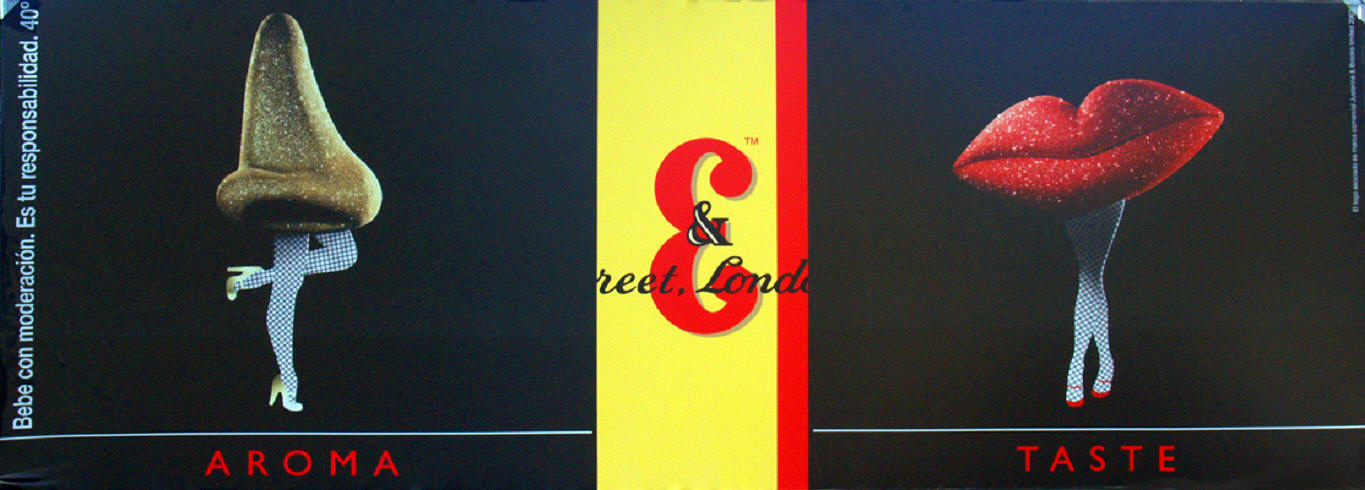
Example 3.A
Advertising Billboard J&B. Slogan: “Scent & flavour”
Zaragoza, Spain 15/01/09

Example 4.A
Advertising Billboard. Ebrosa Building Company. Slogan: “A flow of emotions”
Zaragoza, Spain 04/02/09
Advertising in catalogues and magazines:
Bang & Olufsen, a referent regarding product design, proposes: “Get excited with Bang
& Olufsen”.
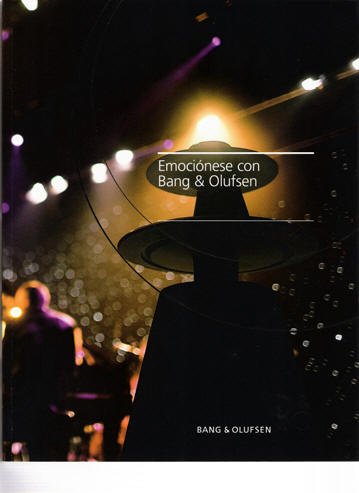
Example 5.A
Catalogue cover 2007-2007. Slogan:
“Get excited with Bang & Olufsen”
Canon also adds the emotional tone to advertise its model EOS Digital
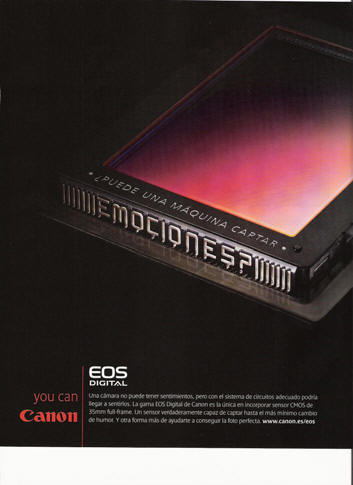
Example 6.A
Advertising in magazine. Digital photographic camera Canon EOS. Slogan:
“Can a machine capture emotions?”
Advertising on informative leaflet to present the designs of a shoe collection.
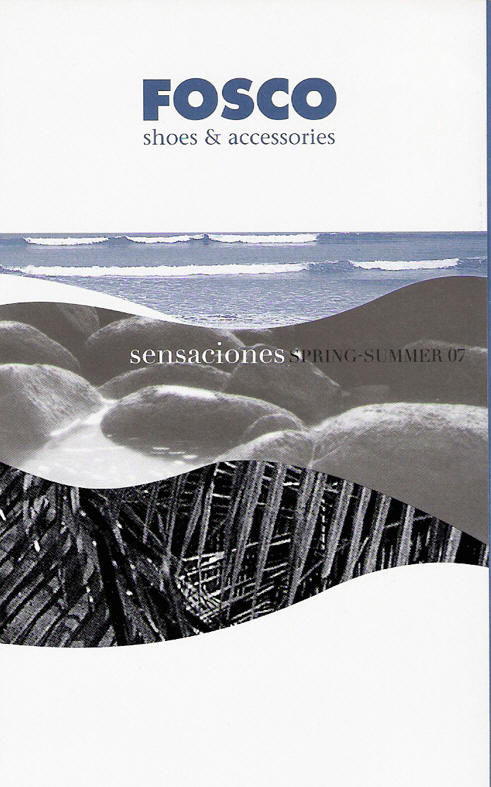
Example 7.A
Advertising on informative leaflet. Fosco shoe shop. Slogan:
“Feelings spring- summer 2007”
Advertising on the Internet.

Example 8.A
Advertising of Control condoms. Series Sex Senses
“A new experience for your senses comes to life. The new aphrodisiac condoms Sex Senses designed by
Aphrodite. Three exciting and original scents that will release passion and will enable you to discover a
universe of feelings”
Services as different as those offered by a financial institution (example 9.A), a casino (10.A) or a cultural space (11.A), coincide in highlighting the sensorial aspects present in their services.

Example 9.A
Advertising Criteria Caixa Corp. Slogan:
“Investment Sense”
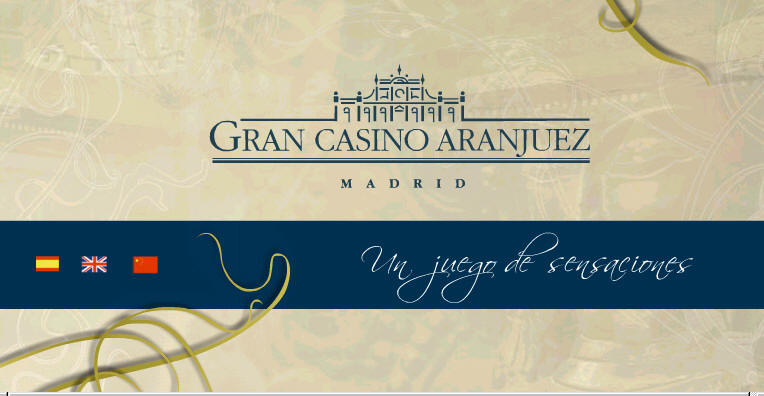
Example 10.A
Advertising Great Casino of Aranjuez. Slogan:
“A game of sensations”


Example 11.A
Advertising of the City of Arts and Science. Slogan:
“Emotion is inside”
Communicating a company image being aware of sustainability on the planet by means of emotional symbols is a direct resource towards the heart of the user/consumer.
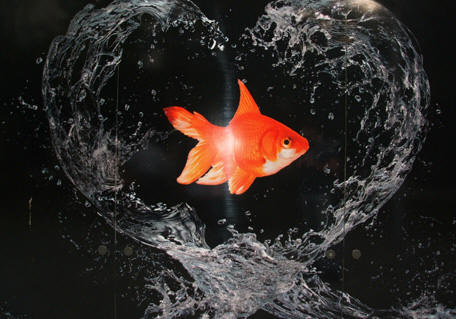
Example 12.A
Advertising of the company Balay to help sustainability
Feeling the emotion in a cultural event is the idea deduced from the slogan that appears in the banderole.
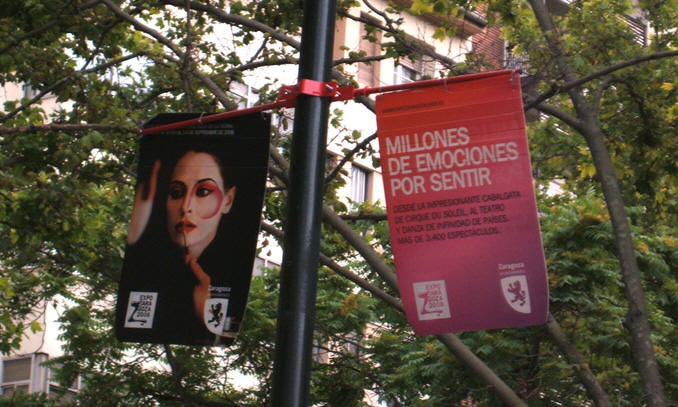
Example 13.A
Advertising in Expo Zaragoza 2008. Slogan: “Millions of emotions to be felt”
The mobile telephone company Movistar in its 2007 advertising campaign, invited users to live Christmas with excitement.

Example 14.A
Advertising of the telephone company Movistar. Slogan:
“Live Christmas with excitement”
The adoption of an emotional branding has been consolidated with strength as a solid and effective strategy. Brands show their “unconditional love” towards us, and towards all that worries us and try to excite us with their products.

Example 15.1.A
Advertising on Flora margarine. Slogan:
“Flora loves your heart”
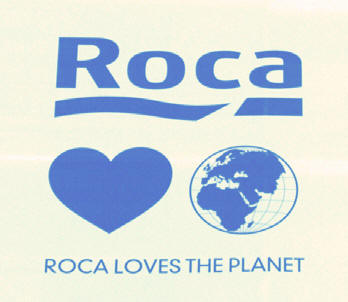
Example 15.2.A
Advertising of the company Roca. Slogan:
“Roca loves the planet”

Example 15.3.A
Advertising of the car manufacturer Seat. Slogan:
“Seat autoemotion”
Block B (1.B-15.B) Emotional elements in Mass Consumption Products
In order to enable a product to be viewed in a positive way by the consumer, it must gather and adequately convey its properties by means of all the visible elements it contains: shapes, materials, colours, finish, etc. All these characteristics will convey their semantic and aesthetic qualities due to the fact that they will be reflected by the product and received by the consumer. Increasing the emotions and experiences by means of the design is an efficient stimulus. Beyond making easier consumption and product information, most of the brands have chosen as a business strategy endowing the product with and individual and imaginary dimension, transforming it in a powerful strength that induces you to feel. Assessing the communicative aspects that take part in the packaging to provide rewarding and pleasurable feelings is one of the premises considered in some designs resulting in proposals for multi-sensorial packaging that traps the senses. Proposing pleasant, playful, sensual or energising experiences, when consuming the product, has become an objective that the packaging is able to transmit.
Thus, when referring to sense involvement at the moment of consumption it is possible to emphasise perception and the pleasure obtained or even associate a particular experience.
The following examples are Mass Consumption Products oriented to satisfy the expectations of those consumers who are allured by the associated feelings and
experiences that arise in them when they see and consume the product. Due to the packaging the brand Kandoo proposes a new way of consumption. Beyond
its container function the packaging, with its game box shape, acts as a catalyst that transforms the consumption experience in an amusing experience.
Example 1.B
Kandoo by Dodot
Nenuco Spa proposes a packaging that stimulates the senses by means of sounds and
textures at the same time that it links personal hygiene to a playful experience.
Example 2.B
Nenuco Spa
The water Font Vella Sensación has included the experiential component by means of
its name, associating its consumption to a feeling of positive experiences for the body.
Example 3.B
Water Font Vella Sensación
15
The Magnum ice-creams presented a limited edition, exclusively devoted to the five
senses, in which the pleasure of the flavour of each ice-cream was emphasised by one of
the senses.
Example 4.B
Limited edition packaging of Magnum five senses
A sample of the emotional component conveyed by the packaging shape and graphic is
presented by the following chocolate boxes.
Examples 5.B, 6.B and 7.B
Packaging chocolate boxes by Lindt, Laura and Milka
The heart symbol has become one of the most used elements in this “feelings period” of
communication. Intuition, affection and sensitiveness are key concepts that should be
aroused in the consumer. By the addition of the “heart” element, on packaging graphics,
a close and clear message, with reference to the benefits of the product, is conveyed.
Examples 8.B and 9.B
Packaging of Vivesoy pineapple and soya. Packaging Carrefour yoghourt
16
Continuing with the tone of the rewarding feelings, the brands Brugal and Trident
propose enjoying the feelings by the consumption of their products.
Examples 10.B and 11.B
Packaging Brugal Añejo and Bubble gum Trident Senses
In the same way, attributing a care and cuddling image to products devoted to the
cleaning of delicate items of clothing adjusts perfectly to the tone of emotional
discourse. “Cuddle your senses and your clothes with subtle almond touches”. Is the
slogan used by Mimosín créme in order to describe the qualities of the product. The
packaging of Mimosín transforms the ergonomics of its design in a feeling of care for
the clothes.
Examples 12.B and 13.B
Packaging Mimosín Créme and washing liquid Ariel Sensaciones
17
Products as different as those belonging to the household or snacks, include the concept
of “feeling” in order to emphasise a more complete and intense perception of the
product.
Examples 14.B and 15.B
Packaging of Luminarc flutes and Lays chips
An idea appears constantly in all these examples: do not stop feeling what the product
offers you and experience everything that the product can convey to you.
Product = to be + to feel
Conclusions
The application of emotional solutions reinforces its presence due to the fact that it
appears in different disciplines that interact jointly exercising a strong strategic power.
This is the reason why a certain degree of poverty is found in the discourse and in the
tone used, when these products are presented before the consumer. Irrespective of the
product or service the addition of Experiential Marketing has covered with an aureole of
intense feelings and emotions the environment that accompanies the product. The
product is much more than what you see. The product is what makes you feel. Before a
multi-dimensional and ever-changing consumer the most effective strategy is the one
that approaches the left side of the consumer’s brain. The encounter with the
individual’s emotional part is located in the fore sight, when communicating the
attributes of the product. The rediscovery of the senses and of their importance in the
18
perception process is proportional to the intensiveness and implication of the latter.
Therefore, the capacity to enjoy and the emotions experienced will be bigger.
Products and services have become what the consumer wants to feel, understanding this
consumption as a mirror of the social trends and transformations. This gives way to a
“feelings generation”: a generation that cannot stop feeling. The brands aware of this
fact, declare their unconditional love and their worry about all that worries us. From
here on, quantifying and directing the consumer’s perception is one of the strategic
objectives aimed at by the business world. Knowing the semantics of a product (service
or brand), that is, its meaning, the perception and the value that the product acquires for
the consumer will provide a result applicable to the implementation of a better final
product or service.
References
· Bagozzi, R. P.; Moore, D. J. (1994). Public service advertisements: Emotions and
empathy guide prosocial behavior. Journal of Marketing, 58: 56–70.
· Barnes, C.; Southee, C.; Henson, B. (2003). The impact of affective design of product
packaging upon consumer purchase decisions. International Conference on Design
Pleasurable Products and Interfaces (134-135).
· Bradiot, Néstor P. Neuromarketing, Neuroeconomía y Negocios. Editorial puerto
NORTE-SUR S.L. Madrid, 2005.
· Burns, A.; Barret, R.; Evans,S. (1999). Delighting Customers through empathic
design. 4th. International Product Development Management Conference.
· Desmet, P. Designing Emotions. Editor: Pieter Desmet. België, 2002.
19
· Gentile, C.; Spiller, N.; Noci, G. (2007). How to Sustain the Customer Experience: An
Overview of Experience Components that Co-create Value With the
Customer. European Management Journal 25 (5): 395-410.
· Gobé, M. Branding Emocional. Editorial Divine Egg. Studio Divine Egg. Barcelona,
2005.
· Goleman, D. lnteligencia emocional. Editorial Cairos. Barcelona, 1996.
· Henson, B.; Barnes, C.; Livesey, R.; Childs, T.; Ewart, K. (2006). Affective consumer
requirements: A case study of moisturizer packaging. Concurrent Engineering Research
and Applications, 14 (3): 187-196.
· Kniazeva, M.; Belk, R. (2007). Packaging as Vehicle for Mythologizing the Brand.
Consumption Markets & Culture, 10 (1): 51-69.
· Lenderman, M.; Sánchez, R. Marketing Experiencial. ESIC Editorial, Madrid, 2008.
· Nagamachi, M. (2002). Kansei engineering as a powerful consumer-oriented
technology for product development. Applied Ergonomics, 33 (3): 289-294.
· Nagamachi, M. (1995). Kansei engineering: a new ergonomic consumer oriented
technology for product development. International Journal of Industrial Ergonomics, 15:
3-11.
· Norman, D. A. El diseño emocional. Ediciones Paidós. Barcelona, 2005.
· Punset, E. El viaje a la felicidad. Ediciones Destino S.A. Barcelona, 2007.
· Schutte, S. (2002). Designing Feelings Into Products -Integrating Kansei Methodology
in Product Development-. Linkoping University, Linkoping Studies in Science and
Technology, Thesis Nº. 946.
· Sedgwick, J.; Henson, B.; Barnes, C. (2003). Sensual Surfaces: Engaging Consumers
Through Surface Texturas. Proceedings of the International Conference on Designing
Pleasurable Products and Interfaces (148-149).